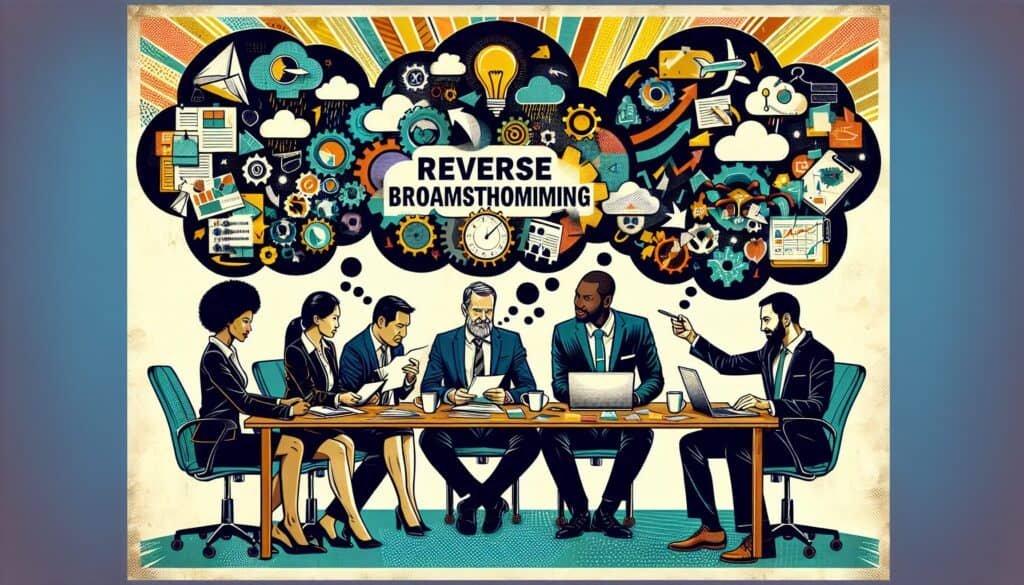Erkennen potenzieller Probleme, Schwachstellen oder Möglichkeiten, wie ein Plan scheitern könnte, um sie proaktiv anzugehen.
- Methodologien: Wirtschaft, Lean Sigma, Herstellung, Problemlösung, Qualität
Umgekehrtes Brainstorming

Umgekehrtes Brainstorming
- Brainstorming, Änderungsmanagement, Kontinuierliche Verbesserung, Analyse des Versagens, Innovation, Problemlösungs-Techniken, Prozessverbesserung, Risikoanalyse, Risikomanagement
Zielsetzung:
Wie es verwendet wird:
- Anstatt zu fragen "Wie können wir X erreichen?", fragt die Gruppe "Wie könnte X scheitern?" oder "Wie könnten wir X zum Scheitern bringen?". Die ermittelten Probleme werden dann genutzt, um Lösungen zu finden.
Vorteile
- Hilft bei der Antizipation und Abschwächung von Risiken; fördert kritisches Denken; kann ein guter Ausgangspunkt für Verbesserungsbemühungen sein, indem es sich auf das konzentriert, was zu vermeiden ist.
Nachteile
- Kann manchmal zu einer negativen oder pessimistischen Atmosphäre führen, wenn sie nicht gut gehandhabt wird; eignet sich möglicherweise nicht für alle Arten von Problemen; erfordert die Umgestaltung von Problemen in Lösungen.
Kategorien:
- Ideenfindung, Problemlösung, Risikomanagement
Am besten geeignet für:
- Identifizierung potenzieller Probleme oder Möglichkeiten, wie ein Projekt/eine Idee scheitern könnte, um dann Lösungen zu finden.
Reverse brainstorming is particularly effective in industries such as product design, software development, and engineering, allowing teams to proactively identify failure modes before they manifest in real-world applications. This methodology is well-suited for the early phases of project development, such as concept design and feasibility studies, where understanding potential pitfalls can inform design choices and resource allocation. Facilitators can initiate sessions with diverse teams, including engineers, designers, marketing personnel, and stakeholders, ensuring a broad range of viewpoints and expertise is represented. Participants can collaboratively brainstorm various scenarios that might lead to a product’s failure, such as design flaws, market misalignment, or inadequate user testing. The findings from these discussions can then be systematically addressed through innovative problem-solving techniques, strengthening the robustness of the product or service. Industries that have successfully implemented reverse brainstorming include automotive design, where safety and performance are paramount, and consumer electronics, where understanding user experience and preventing product recalls are crucial. This proactive approach not only enhances the likelihood of success but also nurtures a culture of continuous improvement, fostering an environment where team members feel comfortable expressing concerns and suggestions. Tools like fishbone diagrams or affinity diagrams can be utilized during these sessions to visualize problems and categorize potential failures, thereby guiding the development of targeted solutions to mitigate risks that might otherwise derail a project.
Die wichtigsten Schritte dieser Methodik
- Define the objective or project.
- Formulate failure-oriented questions related to the objective.
- Brainstorm potential ways the project could fail or obstacles that could arise.
- Encourage participants to think broadly and creatively about failure scenarios.
- Prioritize and categorize the identified potential failures based on impact and likelihood.
- Analyze the prioritized failures to identify root causes.
- Develop strategies or solutions to mitigate each identified failure.
- Assign responsibilities for implementing the solutions.
- Establish metrics for monitoring the effectiveness of the solutions.
Profi-Tipps
- Encourage team members to assume the mindset of a competitor or antagonist, enhancing the identification of potential failures from an opposing viewpoint.
- Utilize structured metrics to evaluate the identified risks and their likelihood of occurrence, ensuring prioritization of the most pressing concerns.
- Schedule follow-up sessions specifically for generating countermeasures based on the identified risks, promoting a culture of continuous improvement.
Verschiedene Methoden lesen und vergleichen, Wir empfehlen die
> Umfassendes Methoden-Repository <
zusammen mit den über 400 anderen Methoden.
Ihre Kommentare zu dieser Methodik oder zusätzliche Informationen sind willkommen auf der Kommentarbereich unten ↓ , sowie alle ingenieursbezogenen Ideen oder Links.
Historischer Kontext
1949
1950
1950
1960
1960
1960
1960
1940
1950
1950
1958
1960
1960
1960
1960
(wenn das Datum nicht bekannt oder nicht relevant ist, z. B. "Strömungsmechanik", wird eine gerundete Schätzung des bemerkenswerten Erscheinens angegeben)















Verwandte Artikel
Master Production Schedule (MPS)
Massenanpassung
Marketing-Trichter
Marketing-Audit
MAPO-Index (Bewegung und Unterstützung von Krankenhauspatienten)
Fertigungsressourcenplanung (MRP II)